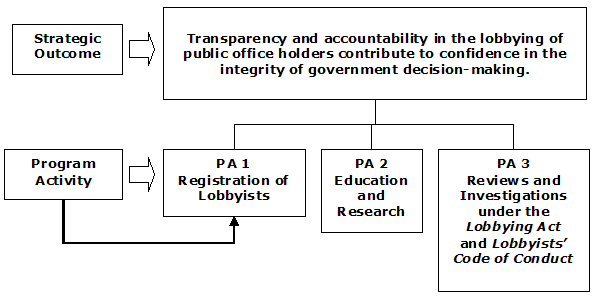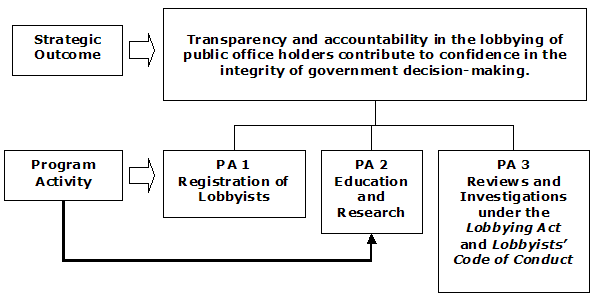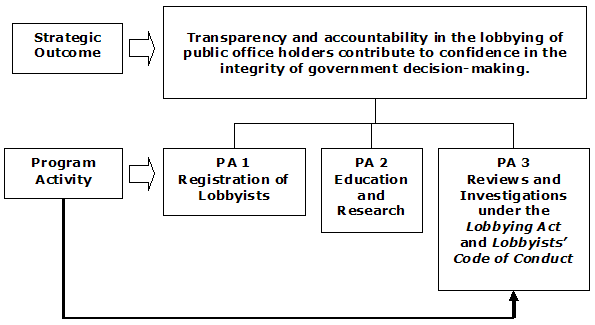Common menu bar links
Breadcrumb Trail
ARCHIVED - Office of the Commissioner of Lobbying of Canada
 This page has been archived.
This page has been archived.
Archived Content
Information identified as archived on the Web is for reference, research or recordkeeping purposes. It has not been altered or updated after the date of archiving. Web pages that are archived on the Web are not subject to the Government of Canada Web Standards. As per the Communications Policy of the Government of Canada, you can request alternate formats on the "Contact Us" page.
Section II – Analysis of Program Activities by Strategic Outcome
2.1 Strategic Outcome
Transparency and accountability in the lobbying of public office holders contribute to confidence in the integrity of government decision-making.
The following section describes the program activities of the Office of the Commissioner of Lobbying and identifies the expected result, performance indicators and targets for each of them. This section also explains how the Office of the Commissioner of Lobbying plans on meeting the expected results and presents the financial and non-financial resources that will be dedicated to each program activity.
This section will contain a discussion of plans surrounding the following Program Activities:
- Registration of Lobbyists
- Education and Research
- Reviews and Investigations under the Lobbying Act and the Lobbyists' Code of Conduct
- Internal Services
2.1.1 Program Activity: Registration of Lobbyists

| Human Resources (FTEs) and Planned Spending ($ thousands) | |||||
|---|---|---|---|---|---|
| 2009-2010 | 2010-2011 | 2011-2012 | |||
| FTEs | Planned Spending | FTEs | Planned Spending | FTEs | Planned Spending |
| 10 | 1,552 | 10 | 1,559 | 10 | 1,560 |
| Expected Result | Performance Indicator | Target |
|---|---|---|
| All lobbying activity is carried out by individuals, organizations and corporations that are properly registered in the Lobbyists Registration System. | Number of active registrations processed in the Lobbyists Registration System. | Increase the number of active registrations processed from 7,500 to 7,875 (5%) by March 2010. |
Program Activity Summary: Lobbying the federal government is a legitimate activity but it must be done transparently. The Lobbying Act requires that individuals who are paid to lobby public office holders disclose certain details of their lobbying activities. The Office of the Commissioner of Lobbying (OCL) analyzes and approves lobbyists' registrations and makes them available for reference in an electronic registry that is accessible on the Internet.
The recent amendments to lobbying legislation brought considerable changes to the registration requirements. In response to these changes, the OCL deployed an online registration system that accommodates the new lobbyist registration requirements. This system allows lobbyists to register their lobbying activities and perform transactions such as amendments, renewals and terminations. It also allows public office holders (POHs) and members of the public to search the registry to increase transparency. In the coming years, the OCL plans to focus on system maintenance and on adapting and enhancing it to be more efficient and meet other organizational objectives.
Performance of the program activity is measured with indicators such as the number of visits to the OCL website, number of active registrations and number of submitted registrations.
The OCL devotes considerable effort to ensuring the integrity of the information held in the Registry. As well, the OCL constantly aims at ensuring that the Registry is up to date and that information can be easily accessed.
Planning Highlights: In order to achieve the expected result, the OCL plans to undertake the following activities:
- Add support for representatives; lobbyists often hire representatives to perform the administrative parts of their work. Often, one representative will support multiple lobbyists; hence, the OCL plans on providing functions that help representatives better manage multiple lobbyists and lobbying activities.
- Improve the search functionality by simplifying and enhancing the user's experience.
- Improve the monthly reporting functions by improving the user interface and business flow.
- Add support for investigation activities.
- Streamline and align business processes and system functions for the registry to increase OCL productivity while reducing operational costs.
Benefits for Canadians: This program activity directly contributes to the increased transparency of lobbying activities at the federal level which, in turn, will increase the confidence of Canadians in their federal institutions.
2.1.2 Program Activity: Education and Research

| Human Resources (FTEs) and Planned Spending ($ thousands) | |||||
|---|---|---|---|---|---|
| 2009-2010 | 2010-2011 | 2011-2012 | |||
| FTEs | Planned Spending | FTEs | Planned Spending | FTEs | Planned Spending |
| 5 | 1,097 | 5 | 1,104 | 5 | 1,105 |
| Expected Result | Performance Indicators | Targets |
|---|---|---|
| Lobbyists, their clients, public office holders and the public are aware of the scope and requirements of the Lobbying Act. |
Number of outreach activities conducted by the OCL.
Survey conducted in the third quarter of every year. |
Increase the number of outreach activities from 33 to 50 by March 2010.
80% say that their awareness has increased. |
Program Activity Summary: The Lobbying Act provides the Commissioner of Lobbying with a formal mandate to establish and implement educational and outreach programs to ensure that lobbying activities at the federal level are conducted in an ethical and transparent manner. The Education and Research Program Activity includes the development and implementation of an educational and outreach strategy to ensure that lobbyists, their clients, public office holders, and the public fully understand the new registration requirements brought forward by the Lobbying Act in a way that increases compliance with the Lobbying Act and the Lobbyists' Code of Conduct.
Planning Highlights: In order to achieve the expected result, the OCL plans to undertake the following activities:
- Develop and implement a comprehensive education and awareness strategy that will set the framework for the OCL's outreach efforts through awareness building activities; partnerships; new information technology tools; direct communications with lobbyists, media, public office holders and the public; advisory letters to lobbyists who may have conducted lobbying activities for which they should have registered but did not; information sessions; media relations; conferences; learning events; briefings for government institutions; and continued dialogue with other jurisdictions and stakeholders.
Benefits for Canadians: This program activity contributes to increased awareness of the requirements of the Act and the Code in order to increase accountability and transparency in the lobbying of public office holders which, in turn, will increase the confidence of Canadians in their federal institutions.
2.1.3 Program Activity: Reviews and Investigations

| Human Resources (FTEs) and Planned Spending ($ thousands) | |||||
|---|---|---|---|---|---|
| 2009-2010 | 2010-2011 | 2011-2012 | |||
| FTEs | Planned Spending | FTEs | Planned Spending | FTEs | Planned Spending |
| 8 | 1,041 | 8 | 1,052 | 8 | 1,054 |
| Expected Result | Performance Indicator | Target |
|---|---|---|
| Alleged breaches of the Lobbying Act and the Lobbyists' Code of Conduct are determined to be either unfounded or true so that they may be subjected to the appropriate sanctions. | Number of alleged breaches of the Lobbying Act and the Lobbyists' Code of Conduct which results in decisions. | Increase the percentage of enforcement actions on alleged breaches from 80% to 90% by March 2010. |
Program Activity Summary: This program activity includes the monitoring of lobbying activity through the media, confirmation of information contained in monthly communication returns, review of applications for exemption from the five-year prohibition on lobbying, and investigation of allegations of non-compliance with the Act or Code. Recommendation reports are prepared and submitted to the Commissioner to facilitate decision-making, and ensure that appropriate compliance measures are taken.
Planning Highlights: In order to achieve the expected result, the Investigations Directorate plans to undertake the following activities:
- Monitor media and other publicly available sources of information for evidence of lobbying, verify that registrable activity is properly reported, advise groups and individuals about the requirement to register certain activity, and make recommendations to the Director of Investigations regarding the appropriate means of ensuring conformity with the Act and Code.
- Confirm the accuracy and completeness of monthly communication returns submitted by lobbyists and take steps to ensure the integrity of information contained in the registry.
- Review applications for exemption from the five-year prohibition on lobbying and provide timely and informative recommendation reports.
- Investigate alleged contraventions of the Act and Code, recommend appropriate compliance measures, assist with the preparation of Reports to Parliament, and communicate results.
Benefits for Canadians: This program activity contributes to public confidence in decisions made by federal institutions by ensuring that lobbying activity is conducted in accordance with the requirements of the Act, and that lobbyists adhere to the principles and rules set out in the Code of Conduct. Increased conformity with the lobbying registration regime ensures accountability and transparency in the lobbying of public office holders.
2.1.4 Program Activity: Internal Services
| Financial Resources ($ thousands) | Human Resources (FTEs) | |||||
|---|---|---|---|---|---|---|
| 2009-2010 | 2010-2011 | 2011-2012 | 2009-2010 | 2010-2011 | 2011-2012 | |
| 884 | 886 | 886 | 5 | 5 | 5 | |
Internal Services are groups of related activities and resources that are administered to support the needs of programs and other corporate obligations of an organization. These groups are: Management and Oversight Services; Communications Services; Legal Services; Human Resources Management Services; Financial Management Services; Information Management Services; Information Technology Services; Real Property Services; Materiel Services; Acquisition Services; and Travel and Other Administrative Services. Internal Services include only those activities and resources that apply across an organization and not to those provided specifically to a program.
